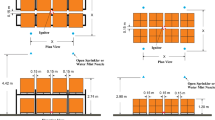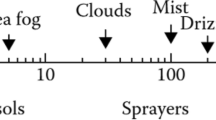Abstract
Water-mist technology provides efficient fire suppression for compartments while minimizing water usage. Even with the many advantages of water mist systems, there is still room for improvement. Water mist systems have demonstrated effectiveness at suppressing flammable liquids (Class B) fires in compartments. However, an especially challenging fire suppression scenario for water mist systems is the small Class B fire. This scenario is often realized after a large fire has been reduced in size or ‘controlled’ by water mist. The small fire scenario is challenging because a small fire may not be able to generate enough vaporized water to displace sufficient oxygen for complete extinction. It should also be noted that even if the Class B fire is extinguished with a water mist system, re-ignition from the hot surrounding surfaces may occur at any time. In the present work, an additive is introduced into the water supply and its effect on the water mist suppression performance is studied. This ForafacTM additive is a specific formulation, which includes fluorinated surfactants for creating a robust fire suppression foam. The enhanced suppressant exiting the mist nozzle is dispersed in the form of small droplets (not as a continuous foam) similar to a pure water mist spray. However, these droplets create a foam blanket on the surface of the fire, which acts to isolate the fuel from the air. With this formulation, the efficiency of the water mist system is improved even on small fires and most importantly the re-ignition of class B fires is prevented.









Similar content being viewed by others
Notes
European parliament legislative resolution on the proposal for a directive of the European Parliament and of the council relating to restrictions on the marketing and use of perflurooctane sulfonates (amendment of council directive 76/769/EEC).
References
Committee on Assessment of Fire Suppression Substitutes and Alternatives to Halon, Naval Studies Board, Commission on Physical Sciences, Mathematics, and Applications, National Research Council (1997) Fire suppression substitutes and alternatives to halon for U.S. Navy applications. National Academy Press, Washington, DC
NFPA (1996) 750: standard on the installation of water mist fire protection systems. National Fire Protection Association, Quincy, MA
Grant G, Brenton J, Drysdale D (2000) Fire suppression by water sprays. Prog Energy Combust Sci 26:79–130. doi:10.1016/S0360-1285(99)00012-X
Notarianni KA (1994) Water mist fire suppression systems. In: Proceedings of the technical symposium on halon alternatives. Knoxville, TN
Pabon M, Copart JM (2002) Fluorinated surfactants: synthesis, properties, effluent treatment. J Fluor Chem 114:149–156. doi:10.1016/S0022-1139(02)00038-6
Weaire D, Hutzler S (1999) The physics of foams. Clarendon Press, Oxford
Boyd CF, diMarzo M (1998) The behavior of fire-protection foam exposed to radiant heating. Int J Heat Mass Transfer 41:1719–1728. doi:10.1016/S0017-9310(97)00280-9
Kim AK, Dlugogorski DS DZ, Mawhinney JR (1994) The effect of foam additives on the fire suppression efficiency of water mist. In: Proceedings of the halon options technical working conference. Albuqerque, New Mexico
Pabon M (2005) New additive for water mist systems on class B fires: toxicological study on breathable particles. In: 6th international water mist association conference. Berlin, Germany
Arridson M, Hertzberg T (2003) The Vinnova water mist research project: a description of the 500 m3 machinery spaces. SP Swed Natl Test Res Inst SP 19
Pepi JS (1995) Performance evaluation of low-pressure water mist system in a marine machinery space with open doorway. In: Proceedings of the halon options technical working conference. Albuqerque, New Mexico
Ural EA, Bill RG (1995) Fire suppression performance testing of water mist systems for combustion turbine enclosures. In: Proceedings of the halon options technical working conference. Albuqerque, New Mexico
UL2167: water mist for nozzles for fire protection service. Underwriters Laboratories, USA February 2004
Acknowledgements
This work is supported by DuPont de Nemours (France). Special appreciation is given to Ms. Wu Di and Messrs. Yaniv Yankovich and Andy Blum for their help in establishing facilities and conducting the experiments used in this investigation.
Author information
Authors and Affiliations
Corresponding author
Rights and permissions
About this article
Cite this article
LeFort, G., Marshall, A.W. & Pabon, M. Evaluation of Surfactant Enhanced Water Mist Performance. Fire Technol 45, 341–354 (2009). https://doi.org/10.1007/s10694-008-0068-2
Received:
Accepted:
Published:
Issue Date:
DOI: https://doi.org/10.1007/s10694-008-0068-2




